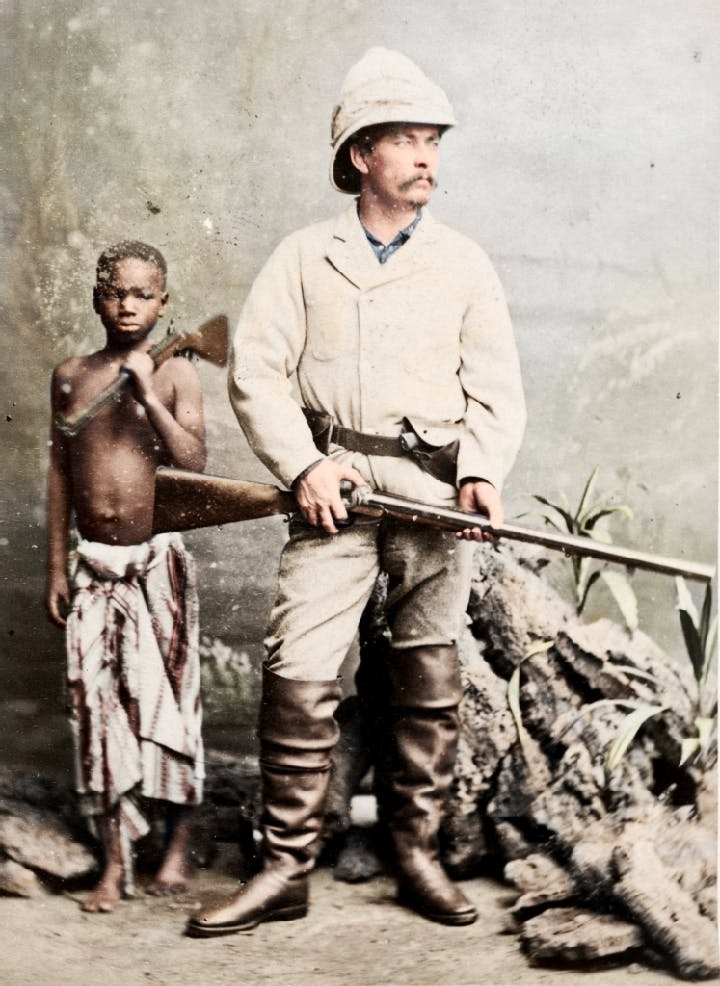Winter 2008
Lost and Found
– Rebecca Clay
A new biography of explorer Henry Morton Stanley uncovers "the truth behind the myth," and "paints a sympathetic portrait of the ultimate self-made man."
John Rowlands’s mother never taught him not to lie. She had neither the time nor the moral inclination: She abandoned her illegitimate son shortly after his birth in Wales in 1841 and didn’t reconnect with him in any real sense until he was well on his way to becoming the world-famous explorer known as Henry Morton Stanley.
That rejection—and his insecurity about social status—drove the grown-up Stanley to say anything for the sake of a good story. A new name wasn’t his only invention. After spending much of his youth in a workhouse, he arrived in the United States in 1859 and created a new nationality (American) and a new father (a wealthy New Orleans cotton dealer). Even “Dr. Livingstone, I presume”—his famous greeting to the long-lost missionary and explorer David Livingstone—turns out to have been a fabrication. Stanley’s efforts at self-invention not only shaped his life, they also proved his undoing. Drawing on a vast trove of newly available materials from the Stanley family archives in Brussels, Tim Jeal’s rip-roaring biography—overflowing with cannibals, exotic diseases, and treacherous cataracts—aims to set the record straight and undo the damage wrought by critics and by Stanley himself.
Even by the time of Stanley’s death in 1904, his reputation was in tatters. Though he had reclaimed his British citizenship, he was denied the honor of being buried in Westminster Abbey near Livingstone’s grave, as he had wished. These days, if remembered at all, Stanley is regarded as a racist who brutalized the natives on his African expeditions and helped King Leopold II of Belgium establish his own personal colony in the Congo—a horrifying regime that led to the exploitation, mutilation, and death of millions of Africans. Indeed, Stanley is often thought to be the model for the evil Mr. Kurtz in Joseph Conrad’s novel Heart of Darkness. But Jeal makes a convincing case that Stanley was not only the most impressive but also the least racist of the European explorers trudging around Africa during the Victorian era.
Clad in a pressed flannel suit and a white helmet, Stanley found Livingstone—emaciated from dysentery, without supplies, and accompanied by only four of his original 59 followers. The newspaper accounts he wrote about the expedition for The New York Herald became literary sensations. He then made a 7,000-mile journey across Africa, during which he mapped the course of the Congo River and thus solved many of the geographic puzzles of the central African watershed. And he led a relief mission to rescue Emin Pasha, a shadowy German serving the British government in Sudan. At a time when “the planet’s remotest places seemed as inaccessible as the stars,” Jeal writes, the mere fact that Stanley came back from these expeditions alive was extraordinary.
But again and again, Stanley undermined hisown accomplishments by failing to tell the truth. Because, as Jeal notes, finding “a forgotten saint made a better story than to have found an embittered recluse” (which Livingstone was), he “gave birth, almost single-handedly, to the Livingstone myth of the noble, self-sacrificing missionary,” and suffered by comparison ever after. Far more troubling are his exaggerated accounts of beating his bearers and killing the natives, which Jeal convincingly argues were the product of a workhouse boy’s desire to appear tough and a journalist’s desire to tell a sensational story. Stanley also published a book that inflated the number of treaties he negotiated on King Leopold’s behalf, setting himself up for criticism that he stole Africans’ land.
In reality, Stanley viewed Europeans as tenants rather than sovereigns in Africa and did his best to negotiate fair treaties with local rulers. He became a “blood brother” of several African chiefs, formed lifelong friendships with many Africans, and “preferred the company of his ‘Dark Companions’ to that of most Europeans,” Jeal says. In Africa, as in America, Stanley escaped from the rigid class system of his own society and felt free to create a new life for himself. By uncovering the truth behind the myth, Jeal paints a sympathetic portrait of the ultimate self-made man.
* * *
REVIEWED: Stanley: The Impossible Life of Africa’s Greatest Explorer. By Tim Jeal. Yale Univ. Press. 570 pp.
Cover photo courtesy of Flickr/Jared Enos
